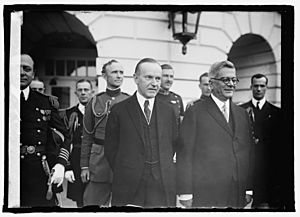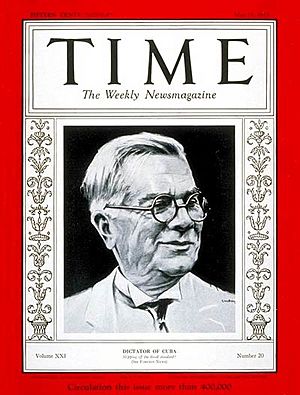Gerardo Machado facts for kids
Quick facts for kids
Gerardo Machado y Morales
|
|
|---|---|
 |
|
| 5th President of Cuba | |
| In office 20 May 1925 – 12 August 1933 |
|
| Vice President | Carlos de la Rosa |
| Preceded by | Alfredo Zayas |
| Succeeded by | Alberto Herrera y Franchi |
| Personal details | |
| Born |
Gerardo Machado y Morales
28 September 1869 Manajanabo, Santa Clara, Spanish Cuba |
| Died | 29 March 1939 (aged 69) Miami Beach, Florida, United States |
| Political party | Liberal |
| Spouse | Elvira Machado Nodal |
| Children | Laudelina (Nena) Machado-Machado Ángela Elvira Machado-Machado Berta Machado-Machado |
Gerardo Machado y Morales (born September 28, 1869 – died March 29, 1939) was an important Cuban leader. He was a general during Cuba's fight for independence. Later, he became the fifth President of Cuba, serving from 1925 to 1933.
When Machado first became president, many people liked him. He had strong support from different political groups. But over time, people started to disagree with him. Many were upset when he ran for re-election in 1928. This was because he had promised to only serve one term. As protests grew, his government limited free speech. They also used strong police actions against anyone who opposed him.
In 1933, Machado had to leave his position. A new temporary government took over. This change was helped by the US ambassador, Sumner Welles. Many people remember Machado as a dictator.
Contents
Early Life and Family
Gerardo Machado was born in 1869 in a place called Las Villas, which is now Villa Clara Province. He was the oldest of three children. He had a brother named Carlos and a sister named Consuelo. They grew up on their family's cattle farm.
During his childhood, his father fought in the Ten Years' War (1868-1878). This was a war against Spain to make Cuba independent. His father became a major in the army. The war ended without Cuba gaining freedom. When Gerardo was in his early twenties, he worked with tobacco, growing and selling it.
Gerardo Machado married Elvira Machado Nodal. She was born in 1868 and lived until 1968. They had three daughters together: Laudelina (Nena), Ángela Elvira, and Berta.
Fighting for Cuba's Freedom
In 1895, Cubans started another war to gain independence from Spain. This was called the Cuban War of Independence. Machado joined the rebel fighters. He quickly became a brigadier general, which is a high rank. He was one of the youngest generals in the war. He fought in the central parts of Cuba.
Life After the War
After the war ended, Machado became involved in politics and business. In 1902, Cuba finally became a fully independent country. Machado was elected as the mayor of Santa Clara.
Later, when José Miguel Gómez was president (1909–1913), Machado held important jobs. He was an inspector for the armed forces. Then, he became the secretary of interior, which meant he was in charge of many government activities inside the country.
After leaving government for a while, he worked in farming. He also invested in companies that provided public services like electricity or water. Once his family was secure, he returned to politics in the early 1920s.
Machado was a leader for the Liberal Party in his home province. He fought on the Liberal side in a conflict in 1917. The Liberals lost this conflict.
In 1924, Machado ran for president as a candidate for the Liberal Party of Cuba. He was allied with the outgoing president, Alfredo Zayas. Machado won by a large number of votes against Mario García Menocal of the Conservative Party. He became Cuba's fifth president. His campaign promise was simple: "Water, roads, and schools."
First Term as President (1925-1929)

Gerardo Machado became President of Cuba on May 20, 1925. His first term was a time of good economic growth for Cuba. The country's sugar production grew a lot. The United States was a close and easy market for Cuban sugar.
Machado started many big projects to improve Cuba. He wanted to make Cuba like the "Switzerland of the Americas." In April 1927, Machado visited the United States. He met with President Calvin Coolidge. They talked about many things, including the Platt Amendment. This was a rule that gave the U.S. some control over Cuba's affairs. Machado said it helped Cuba, but he wanted it changed. He felt it made Cuba seem less independent.
One of his biggest projects was the Central Highway. This highway went almost the entire length of the island. It stretched over 700 miles, from Pinar del Rio in the west to Santiago de Cuba in the east.
Machado also built El Capitolio (The Capitol). This was a grand building for the Cuban Congress. It was built between 1926 and 1929. Its design was meant to show Cuba's hope and strength as a new democracy.
He also helped expand the University of Havana. He improved health facilities across the country. Other important buildings built during his time include the Hotel Nacional de Cuba and the Bacardi Building (Havana). He also created new laws to protect Cuban businesses. Even with these achievements, Cuba still relied heavily on sugar. The United States also had a growing influence in Cuba. To pay for these projects, Machado borrowed a lot of money from other countries. This greatly increased Cuba's public debt.
Second Term and Challenges
Re-election and Protests
Machado had promised not to run for re-election in 1924. But after only two years as president, he changed his mind. In 1927, he pushed for changes to the constitution. These changes allowed him to run for president again. He won the 1928 election.
Many people felt he forced his way into a second term. This act, called continuismo (meaning continuing in power), caused a lot of anger. At the same time, the price of sugar dropped, hurting Cuba's economy. The stock market crash of 1929 made things even worse.
Because of these problems, Cuba became very unstable. Machado faced strong opposition, especially from university students. Students formed a group called the Directorio Estudiantil Universitario (DEU) in 1927. They organized many protests. After some students died, including Rafael Trejo, Machado closed the university in 1930. His government also closed many newspapers and arrested editors.
End of His Presidency
In Cuba, Machado faced many groups who wanted him out of power. These groups included students, veterans, and other political activists. He held onto power for several years despite the struggles.
In May 1933, a new US ambassador named Sumner Welles arrived in Cuba. He started talks with the groups opposing Machado. The goal was to create a new government. A temporary government was formed, led by Carlos Manuel de Céspedes y Quesada. He was the son of a Cuban independence hero. This new government took power in August 1933. This happened during a big general strike in Havana. Ambassador Welles helped weaken Machado's government. He got Machado to agree to things that helped the opposition.
Machado's government collapsed. The army also revolted, demanding his resignation. On August 12, 1933, Machado left Cuba on a flight to the Bahamas.
Gerardo Machado died in Miami Beach, Florida, in 1939. He was buried there at Woodlawn Park Cemetery and Mausoleum.
Writings
Machado y Morales, Gerardo (written in 1936 published in 1957 and later) Ocho años de lucha – memorias. Ediciones Universales, Ediciones Historicas Cubanas. Miami ISBN: 0-89729-328-2
You can find some of Gerardo Machado y Morales's writings and papers online. The University of Miami has them available for research.
Images for kids
See also
 In Spanish: Gerardo Machado para niños
In Spanish: Gerardo Machado para niños




